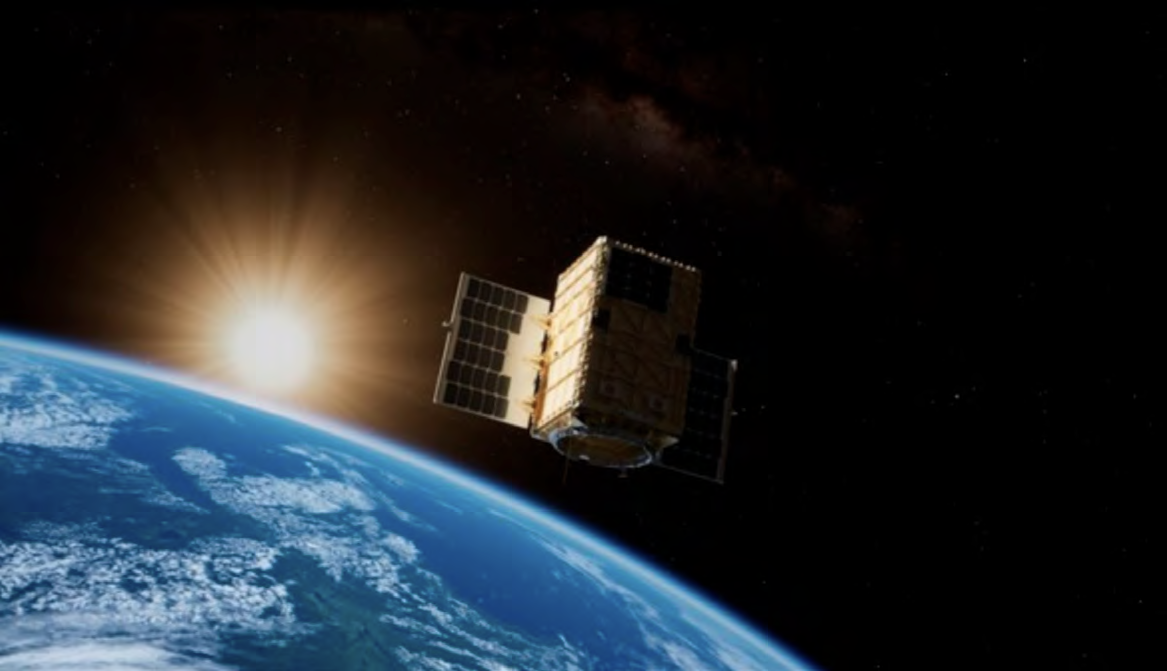SpacePath intros military grade man-pack terminal for troposcatter comms
SpacePath Communications is going to be showcasing their new 40W man-pack terminal for tropospheric scatter (troposcatter) transmission at the Defence in Space Conference (DISC), London.

The military-grade, troposcatter man-pack highlights a cutting-edge solution in the Beyond Line-of-Sight (BLoS) communication segment, combining a BUC, LNB, modem and filters in a single, lightweight, and ruggedized, portable terminal. Offering up to 20W of linear output power and a frequency range of 4.4-5.0GHz, this compact device provides exceptional power density, and weighs less than 6 kg. The robust manpack is designed for long-range, point-to-point communication, ideal for tactical military operations, disaster recovery, and emergency restoration, ensuring reliable communications in locations where traditional SATCOM is unavailable.
Providing exceptional flexibility in deployment, the terminal is compatible with all antenna systems and supports data rates of at least 7 Mbps over distances of up to 70km. The integrated modem with quad-diversity further enhances performance, making it ideal for demanding, tactical communications. SpacePath’s high performance uplink amplifiers cover all mission-critical segments including highthroughput satellite (HTS), mobile satellite, fixed-Earth stations and MILSATCOM.
Colin Bolton, director of business development, SpacePath Communications, said, “This new development reinforces SpacePath’s position as a supplier of choice for mission-critical connectivity. Leveraging our design expertise, we have broadened our portfolio in troposcatter systems to include a military-grade, microwave terminal for communications beyond the horizon while on the move.”
RTX’s Raytheon + Northrop Grumman successfully test solid rocket motor
Raytheon, an RTX (NYSE: RTX) business, and Northrop Grumman (NYSE: NOC) have successfully completed a static fire test of an advanced, long-range, solid rocket motor at the Northrop Grumman Allegany Ballistics Laboratory in West Virginia.

The test demonstrated wired, end-burning technology for hypersonic applications and provided data to support digital modeling and simulations that validated the design maturity and performance of the rocket motor. Raytheon’s Advanced Technology team and Northrop Grumman leveraged their combined digital engineering expertise to accelerate the design and development in a digital environment using model-based systems engineering.
Raytheon and Northrop Grumman share a long history of collaborating on the development of hypersonic systems. Both are making investments in rocket motor testing to prove design stability and maturity that is necessary to deliver capability to servicemen and women on an accelerated schedule.
“This is a major milestone in proving the significant capability of this solid rocket motor,” said Colin Whelan, president of Advanced Technology at Raytheon. “By leveraging industry collaboration, we were able to demonstrate that we can produce and meet requirements for challenging long-range fires kill chains.“
“This extremely important test of our wired end-burning technology provides extended range over conventional rocket motors,” said Frank DeMauro, vice president, Weapon Systems, Northrop Grumman. “We are excited to rapidly push the boundaries on next-generation propulsion technology and provide our customers with the ability to respond to evolving threats.”
SATCOM providers changing tactics to compete with NGSO-led capacity growth
Novaspace has released its latest edition of the ‘Satellite Connectivity & Video Market’ report, revealing significant shifts across the SATCOM industry.

The past three years have seen a dramatic, eight fold increase in global satellite capacity supply, reaching around 27 Tbps in 2023, a figure that is accounted for more than 80% by Starlink.
This dominance can be partially attributed to delays from initial target dates from most other constellation projects and software- defined satellites. However, new LEO constellations, such as Telesat, Lightspeed, and Amazon Kuiper, alongside second- generation Starlink and Eutelsat OneWeb constellations, as well as Very High Throughput Satellites (VHTS) such as Viasat-3, are expected to drive growth to 260 Tbps by 2029.
The rise of Non-Geostationary Satellite Orbit (NGSO) systems has caused a decline in orders for GEO satellites, as operators have adopted a “wait and see” approach. Despite this, GEO capacity still represented approximately 85% of capacity revenues in 2023, though NGSO capacity revenues are projected to grow at a Compound Annual Growth Rate (CAGR) of 27%, surpassing GEO revenues by 2028 and bringing in around $18 billion by 2033.
GEO-High Throughput Satellite (GEO-HTS) systems continue to maintain significant traction in premium market segments, such as MILSATCOM, aeronautical connectivity, and certain areas of fixed broadband, particularly those requiring high uptime or Committed Information Rate (CIR)-based Service Level Agreements (SLAs). However, Starlink accounted for 70% of total HTS traffic in 2023, intensifying competition in key markets like consumer broadband and maritime, further challenging traditional GEO players in these segments.
In response to rising competition, satellite operators are also pursuing vertical and horizontal integration strategies. This includes two significant closed merger and acquisition deals in 2023 – Viasat’s acquisition of Inmarsat and Eutelsat’s merger with OneWeb – as well SES announcing it was acquiring Intelsat in 2024, with regulatory clearances expected to be received in 2025.
Consequently, the rising competition should contribute to the Average Revenue Per Unit (ARPU) for satellite capacity falling below $100 per Mbps per month across most segments by 2033. This price decline is set to unlock new opportunities in rural, remote, and under-connected areas, including those near urban centers and over oceans, driving global capacity demand to 73 Tbps by 2033 (27% CAGR).
The industry’s total service revenues are thus projected to reach approximately $117 billion by 2033, capturing the expanding addressable market. However, the anticipated return to growth in service revenues may be delayed due to a continued rapid decline of the video segment in mature digital markets and a stagnation in previously growing emerging markets, such as South Asia. Additionally, delays in the deployment of NGSO constellations and VHTS capacity have also slowed service revenue growth in key data segments such as Enterprise Networks.
“Facing a shifting landscape marked by declining demand for video broadcasting, fluctuating mobility market patterns, and an influx of capacity from NGSO constellations, satcom operators have been exploring different strategies to survive,” said Dimitri Buchs, Manager at Novaspace and lead author of the ‘Satellite Connectivity & Video Market’ report. “In order to expand market reach, diversify service offerings, and enhance business resilience, capacity providers have been increasingly forming ‘multi-orbit’ partnerships..“
Boeing developing quantum comms tech with in-space test satellite
Boeing [NYSE: BA] has scheduled a 2026 launch of a satellite – dubbed Q4S – which is designed to demo quantum entanglement swapping capabilities on-orbit — this Boeing-funded, first-of-its-kind space mission brings humanity closer to building a secure, global quantum internet that connects quantum sensors and computers.

Artistic rendition of the Boeing Q4S satellite,
courtesy of the company.
Quantum sensors are much more precise than today’s stateof- the-art instruments and quantum computers have the capacity to process large amounts of data, offering potential to revolutionize an array of industries. This experiment is attempting to demonstrate quantum networking in space, helping to better understand how these networks can be built across vast distances and remain highly synchronized.
Boeing is setting the stage for a revolution in how the company handles information with secure, quantum-enhanced applications, such as fault-tolerant systems that reduce errors in computing, secure voting mechanisms that protect electoral integrity, and blind quantum computing which allows data to be processed without exposure.
Entanglement swapping relies on quantum teleportation – a method where the information carried by a particle can be transferred without having to move the particle itself across the distance. Albert Einstein famously referred to this ethereal concept as “spooky action at a distance,” underscoring the complex nature of quantum mechanics. Quantum networking capabilities in space can unlock new potential, helping researchers gather more data about the Earth and space environments – areas where current instrument sensitivity and resolution limit progress. The year-long Q4S demonstration involves two entangledphoton pair sources housed within a space vehicle. Boeing’s payload and technology partner, HRL Laboratories, a joint venture between Boeing and GM [NYSE: GM], has made significant advancements in benchtop exercises as the joint team finalizes technical designs of a space-hardened payload that is ready for launch.
“We’re making a big bet on quantum technology,” said Jay Lowell, chief engineer for Boeing’s Disruptive Computing, Networks & Sensors organization. “Quantum entanglement swapping underpins the communication of the future, expanding quantum networks beyond simple point-to-point communication. We’re launching Q4S to prove it can be done on-orbit. By demonstrating entanglement swapping, we can create a scalable network, where quantum information can be transmitted over vast distances, something currently limited by decoherence and loss.”
“Boeing has always served as a pioneer, pushing the boundaries of what’s possible,” said Todd Citron, Boeing’s Chief Technology Officer. “We’re doing much more than participating in quantum research, we are leading the way to operationalize and scale quantum technologies for global applications.”
Orbit secured million$ advanced SATCOM contract for Asian naval military platforms
Orbit Communication Systems Ltd. received a $6 million contract late last month with a prominent Asian integrator to supply advanced satellite communication (SATCOM) systems for new naval military platforms.

These OceanTRx 7 MIL systems will be delivered between 2025 and 2030, providing continuous satellite connectivity across multiple frequencies for a leading global fleet.
The OceanTRx 7MIL is the latest addition to a long line of more than 30 years’ field proven maritime SATCOM terminal systems with leading NATO and allied navies. It provides reliable, high capacity, long-range communications to navy vessels in extreme conditions. This satellite communication system supports a variety of antenna system configurations.
With a diameter of 2.2 meters, the OceanTRx 7MIL operates on X, Ku, Ka and C frequencies, and enables simultaneous operation of a variety of frequencies for global activities. The OceanTRx 7MIL can be connected to a unique Orbit switching matrix (OSM) which allows multiple internal connections and switching of up to 8 antennas and 8 modems according to customers’ requirements.
The OceanTRx 7MIL is designed to operate in the crowded and hostile EMC environment of a modern warship, and has minimal impact on other communication, sensor and weapon systems. Designed for quick and convenient installation, maintenance and upgrade, the system provides defense customers with a combination of exceptional RF performance and availability.
Daniel Ashchar, CEO of Orbit, said, “This order represents another significant milestone in expanding our order backlog this year. We are proud to continue our partnership with a leading Asian integrator, delivering Orbit’s cutting-edge systems for a prominent global fleet. The OceanTRx 7Mil platform underscores our leadership in military marine communication solutions, offering a dual-band capability that meets both military and civilian needs on a single system. We are committed to building a significant backlog to support our ongoing growth as a leading company in our field.”



